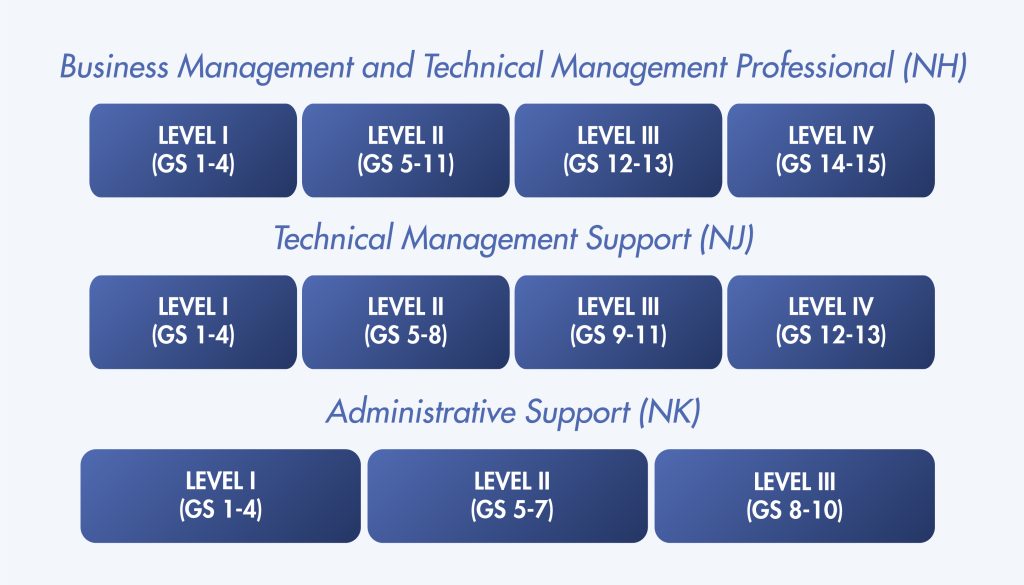
WORK HARD FOR THE MONEY: Under the GS pay system, salary increases are dictated by time in grade—but with AcqDemo, employees are paid based on their contributions to the organization’s mission. (Photo by Tima Miroshnichenko, Pexels)
Various government agencies are shifting away from the traditional GS pay system to contribution-based pay.
by Rebecca Wright
Any employee working for the federal government is likely familiar with the General Schedule (GS) classification and pay system. The original GS system was created by the Classification Act of 1923, then later refined and enacted into law by the Classification Act of 1949. Although almost 75 years old since its final establishment, the GS system is still the most widely used pay scale within the federal government, covering more than 1.5 million employees. But how many federal employees are familiar with other pay structures outside of the GS system?
In 1999, the Department of Defense began implementing the DOD Civilian Acquisition Workforce Personnel Demonstration Project, or AcqDemo for short. The Army defines the AcqDemo project as “a Congressionally mandated project designed to show that the DOD acquisition, technology, and logistics workforce can be improved by providing employees with a flexible, responsive personnel system that rewards employee contribution and provides line managers with greater authority over personnel actions.”
So, how does it work? And what does it mean for the employees of the acquisition workforce that are covered by the AcqDemo project? Employees of the acquisition workforce currently covered by the AcqDemo project might be surprised to learn about the more flexible career growth opportunities and the possibility to advance in pay at a much quicker pace.

BROADBAND LEVELS: AcqDemo’s broadbanding divides the acquisition workforce into three career paths; each career path consisting of three or four broadband levels and eliminates the use of steps. (Graphic by U.S. Army Acquisition Support Center)
THE INS AND OUTS
The AcqDemo project’s key differences from the GS system include streamlining job series classifications with the implementation of broadbanding, a job performance rating system and a simplified and accelerated hiring process.
The current GS system consists of 15 grades (GS-1 through GS-15), and within each grade are ten steps. To receive step increases (commonly referred to as within-grade increases or WGIs), the waiting period is one year per step to move through steps one through three; two years per step to move through steps four through six; and three years per step to move from step seven through step ten. In most instances, a new federal employee hired into the GS system will begin at step one of the applicable GS grade. Therefore, it typically takes an employee in the GS system 18 years to progress from step one to step ten within the same grade. In addition to grades and steps, job positions in the GS system are classified into 22 occupational families that include more than 400 occupational series. While still retaining occupational series and job titles, AcqDemo’s streamlined manner of broadbanding replaces the occupational families by dividing the acquisition workforce into three career paths; each career path consisting of three or four broadband levels. The broadband levels also combine several GS grades into one, eliminating the use of steps.
The career paths and broadband levels include Business Management and Technical Management Professional (NH), Technical Management Support (NJ) and Administrative Support (NK). The Business Management and Technical Management Professional path and the Technical Management path each contain four levels (level I through level IV) while the Administrative Support path contains three levels (level I through level III). By restructuring the GS grades and occupational families into career paths, this allows for a more competitive recruitment of qualified candidates. It also allows the use of broader pay ranges to set pay. With this capability, agencies can attract and retain talented employees. In conjunction with competitive recruitment and salary, the broadband levels allow more opportunities for current employees to transfer into different positions and career paths, if desired.
In a continuing effort to attract a high-quality workforce, the federal government is making attempts to expedite the hiring process. One of those efforts includes the authorization to use direct-hire authority (DHA). DHA allows agencies to fill job vacancies by eliminating some of the traditional hiring procedures such as the rating of applicants. DHA also presents the option to set limits on the number of applications received in an effort to control a large number of applicants. Many potential employees are discouraged by the length of time it takes to complete the federal government’s hiring process. After the initial submission of an application, it can take months to complete the process from start to finish. The Office of Personnel Management can grant agencies authorization to use DHA to fill certain job positions—specific occupational series, grades or geographic locations—when a shortage of experienced candidates exists.
The Army anticipates the possibility that the acquisition workforce will decline in the coming years. To stay ahead of a potential staffing shortage, the AcqDemo project authorizes the use of DHA. With this authorization, vacancies for acquisition coded positions may be filled by qualified candidates possessing at least a bachelor’s degree. DHA may also be used to fill positions that are categorized as non-acquisition but will involve direct support of an acquisition position at least 51 percent of the time.

WORKFORCE LONGEVITY: The AcqDemo pay system can help recruit and retain a talented workforce. (Photo by Antoni Shkraba, Pexels)
A NEW WAY TO MOVE UP THE LADDER
While performance level is considered a factor in the GS system, WGIs rely most heavily on longevity. According to the results of the 2022 Federal Employee Viewpoint Survey (page 32), when employees were asked how poor performers are addressed in their agency, 42 percent of respondents answered that the poor performers “remain in the work unit and continue to underperform.” In the GS system, an employee is expected to perform their job at an acceptable level and if the employee fails, then a WGI can be withheld. However, in April 2021, a study conducted by the U.S. Merit Systems Protection Board (MSPB) determined that the denial of WGIs for poor performers are uncommon. The MSPB survey results stated “that more than one in four supervisors believes they have at least one employee who is not at an acceptable level of competence. If each supervisor had 10 employees, that would suggest a WGI denial rate of at least 1 in 40. Personnel action data reflects a much lower rate, just over 1 in 1,000.” So, if WGIs and salary increases are not commonly denied when performance levels are not met, how does this incentivize poor performers to improve? More importantly, there is the morale of those who perform at higher levels to consider.
With typical progression in the GS system primarily depending on years of service in the workforce, the AcqDemo project has a different approach for upward mobility. Instead of relying on years of service and by eliminating WGIs, employees covered under AcqDemo are rated on their performance and their contributions made to the mission. Since AcqDemo is a contribution-based performance system, it presents an opportunity for federal employees to advance more quickly in pay compared to its GS counterpart.
Fundamental to the AcqDemo project is the Contribution-Based Compensation and Appraisal System (CCAS), a rating and performance management system. CCAS is used to measure an employee’s contribution to the mission as well as how well the employee is performing. The system consists of three main elements: the contribution plan, the midpoint review and the annual assessment. Employees are offered the option to write self-assessments at the midpoint review and annual assessment, providing an opportunity to highlight their accomplishments. High-performing employees are rewarded with larger-than-average basic pay increases. As a result, AcqDemo can provide more flexibility when it comes to compensation. With this flexibility, an employee who is performing the job at or above expectations can move up in the salary pay band at a much quicker pace than it takes to move from step one to step ten in the GS system. And since broadband levels are comparable to GS grades, salaries are consistent with those that are covered under the GS pay scale.

CLIMB THE CAREER LADDER: AcqDemo allows employees more flexible career growth opportunities than the GS pay system. (Image by Gerd Altmann, Pixabay)
WHAT OTHER CHANGES ARE THERE?
It is commonly known that GS employees in the federal government are offered a comprehensive benefits package. While AcqDemo’s primary changes include job series classifications and broadbanding, performance ratings and a simplified hiring process, all employee benefits remain in place. AcqDemo employees are offered the same insurance options, retirement plans, leave accruals, legal protections, etc., as an employee covered under the GS system. The following employee benefits remain in place under the AcqDemo project:
- Health, dental and vision insurance.
- Life insurance.
- Retirement plans.
- Leave accrual.
- Work schedules.
- Travel and allowances.
- Veteran’s preference.
- Merit system principles.
- Prohibited Personnel Practices.
- Anti-discrimination laws.
- Whistleblower protection.
- Fundamental due process.
Additionally, since AcqDemo broadbands are based on a combination of GS grades, each year—if there is a general pay increase—the broadband salaries will be adjusted upwards in accordance with the new GS pay schedule. Therefore, AcqDemo employees will still receive the same annual pay increases authorized by the president or Congress as GS employees.
CONCLUSION
As of March, according to the AcqDemo website, there are a total of 54,031 employees covered under the AcqDemo project—including participants from the Army, Navy, Marine Corps, Air Force and various other DOD agencies. Out of that total number, 13,749 are members of the Army Acquisition Workforce. In November, that number is expected to rise by an additional 371 employees when the U.S. Army Corps of Engineers, Mississippi Valley Division joins the AcqDemo project.
So, will all federal agencies eventually replace the GS system with contribution-based performance systems? Not anytime soon. AcqDemo is not yet a permanent pay system and still requires periodic renewals or extensions. As of right now, the National Defense Authorization Act has extended AcqDemo through December 31, 2026, and limits the number of participants at 130,000. However, if the project becomes permanent, it anticipates additional agencies will participate.
With over 20 years in operation, the AcqDemo project has demonstrated great success and continues to see an increase in participation. Although AcqDemo is not yet permanent, it continues to seek permanency every fiscal year.
For more information about AcqDemo, contact AcqDemo.Contact@dau.edu.
REBECCA WRIGHT is a writer and editor for Army AL&T magazine at the U.S. Army Acquisition Support Center at Fort Belvoir, Virginia. She has over 14 years of experience writing and editing for the Department of Defense and the Department of Justice.







